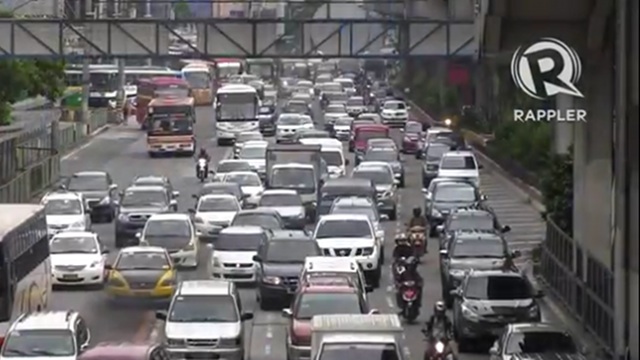SUMMARY
This is AI generated summarization, which may have errors. For context, always refer to the full article.
 It was perhaps fortuitous that Filipinos woke up on the first day of 2014 to news that air pollution had just reached an all-time high.
It was perhaps fortuitous that Filipinos woke up on the first day of 2014 to news that air pollution had just reached an all-time high.
In fact, you didn’t have to open a newspaper or news site to see the suffocating smog covering the Metro Manila skyline on that first 2014 morning.
Soon, the Department of Environment and Natural Resources (DENR) revealed that air pollution the morning after New Year’s Eve was 300% more than last year’s.
It was also 10 times more than air quality standards deemed safe by the World Health Organization.
If that number is 150 ug/Ncm (micrograms per normal cubic meter of air), air pollution climbed to 1,550 ug/Ncm for the entire Metro Manila during the few hours after 2013.
This is the measurement of the amount of tiny solid and liquid particulates in the air. Such particulates are so small they can enter the lungs and cause lung cancer, according to Environment Secretary Ramon Paje.
This less than pleasant New Year surprise brings attention to the frustrating fact that even on normal days, air quality in the entire Philippines is not safe for humans.
According to the Clean Air Act, an acceptable amount of total suspended particles (TSP) in the air is 90 ug/Ncm. The lowest TSP level so far attained by the country is 106 ug/Ncm – still 16 points beyond the safe level.
Two solutions
During a press briefing on Friday, January 3, Paje said the country will never significantly bring down air pollution unless we do two things: retrofit our fuel and solve our horrendous traffic problem.
Since 2010, the DENR already undertook to shift the Philippines to “cleaner” fuel. The agency ordered that starting January 2016, all new passenger and light-duty cars introduced to the market should comply with Euro 4 emission limits and must drive on Euro 4 fuel.
Euro 4 is a kind of fuel that has less sulfur content than more commonly-used fuel. Less sulfur content means less particles emitted by a vehicle using the fuel. This ultimately means less air pollution.
Euro 4 fuel has only 50 parts per million (ppm) sulfur content compared to 500 ppm of Euro 2 fuel still being used by most cars in the Philippines today.

The good news is, shifting to Euro 4 is so achievable that the DENR has moved the deadline sooner.
The measure can be applied by end of 2014 instead of by January 2016 because major fuel providers have already begun retrofitting their facilities to accommodate this kind of fuel, said Paje.
In fact, Petron has already launched Blaze 100 Euro 4, marketed as the first Euro 4 premium plus gasoline in the country.
As environmentalists would say, the sooner the better. It takes around 15 years to replace in-use vehicles with those that can run on cleaner fuel. The sooner Euro 4 fuel is introduced, the sooner vehicle replacement can start.
Hydra-like traffic problem
The bad news is linked to the second solution.
As long as urban traffic problems exist, the benefits of cleaner fuel will practically be nullified.
No matter how clean our vehicles are, if they are kept on the road longer than they are supposed to be, they will still emit tons of air-polluting particles.
Here’s a real life example.
It takes around 15 minutes to get from North Avenue in Quezon City to Makati at 3 am. But at 5 pm, it can take an hour.
If a car emits 1 kilo of carbon monoxide in 15 minutes, it emits 4 times that amount in an hour. So even if your car uses cleaner fuel, simply because of traffic, you emit 4 times as much air pollution.
But we all know traffic is a many-headed hydra that sprouts more problems when we think we’ve solved one. (READ: Taming the traffic beast of Metro Manila)
Take as an example the implementation of car-coding which only convinced the middle to upperclass to buy more cars to use when one car is not allowed. A measure to lessen cars on the road only added to them.
Suddenly, life in Metro Manila is a hellish commute unless you can afford a car.
Despair for air
Add smoke-belching vehicles to the mix and you have one truly stinking brew. Despite the Clean Air Act, ill-maintained jeepneys and taxis and decade-old buses still rampage in the streets of our highly-urbanized cities.
No wonder the country spends P7 billion annually treating pollution-caused illnesses. According to the health department, more than half of medicines sold in Metro Manila is for upper respiratory diseases.
The solution to air pollution is a problem as hard to capture as the element itself.
As air dissipates quickly, moves from one place to another and escapes from the tightest of grips, the solution to air pollution remains elusive, almost abstract in its complexity.
The Clean Air Act is almost 15 years old yet healthy air is still beyond our reach.
It’s easy to fall into the trap of despair. But there are concrete steps and feasible measures we can implement and follow. There are clean technologies to embrace and reforms in the transportation sector to consider.
We can’t allow helplessness to build up like smog gradually ruining a New Year dawn. Instead, let ideas and political will come as swift as wind to blow away the mire of the past. – Rappler.com
Pia Ranada is a Rappler multimedia reporter covering the environment and agriculture beats.
iSpeak is a parking space for ideas worth sharing. Send in your contributions to move.ph@rappler.com.
Add a comment
How does this make you feel?
There are no comments yet. Add your comment to start the conversation.